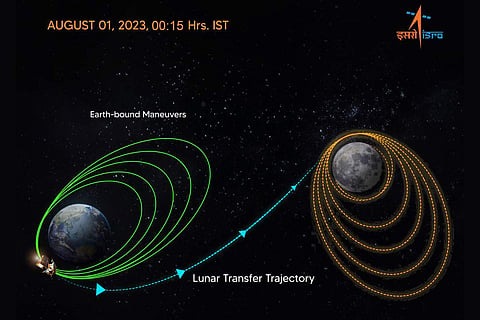
- LIFESTYLE
- FASHION
- FOOD
- ENTERTAINMENT
- EVENTS
- CULTURE
- VIDEOS
- WEB STORIES
- GALLERIES
- GADGETS
- CAR & BIKE
- SOCIETY
- TRAVEL
- NORTH EAST
- INDULGE CONNECT

Indian Space Research Organisation (ISRO) on Tuesday successfully injected the Chandrayaan 3 -- spacecraft to the moon -- into the TransLunar orbit, an official said.
"Chandrayaan-3 completes its orbits around the earth and heads towards the moon. A successful perigee-firing performed at ISTRAC, ISRO has injected the spacecraft into the translunar orbit. Next stop: the Moon. As it arrives at the moon, the Lunar-Orbit Insertion (LOI) is planned for August 5, 2023," ISRO tweeted.
Translunar orbit injection is the process whereby the moon-bound spacecraft is put into a trajectory so that it can reach the moon. The Indian space agency said it will carry out the LOI process on August 5, 2023.
The Chandrayaan-3 spacecraft was put into orbit on July 14, 2023, in a copybook style by India's heavy lift rocket LVM3. The Chandrayaan-3 spacecraft comprises a propulsion module (weighing 2,148 kg), a lander (1,723.89 kg) and a rover (26 kg). The main object of the mission is to safely land the lander on the lunar soil.
The lander will get separated from the propulsion module a couple of days after it enters lunar orbit. The lander is expected to make a soft-landing near the South Pole of the moon on August 23 evening at 5.47 p.m. The lander will descend to the moon from a height of about 100 km from the moon's surface.
The soft landing is a tricky issue as it involves a series of complex manoeuvres consisting of rough and fine braking. Imaging of the landing site region prior to landing will be done for finding safe and hazard-free zones.
Subsequent to the soft landing, the six-wheeled rover will roll out and carry out experiments on the lunar surface for a period of one lunar day which is equal to 14 earth days.